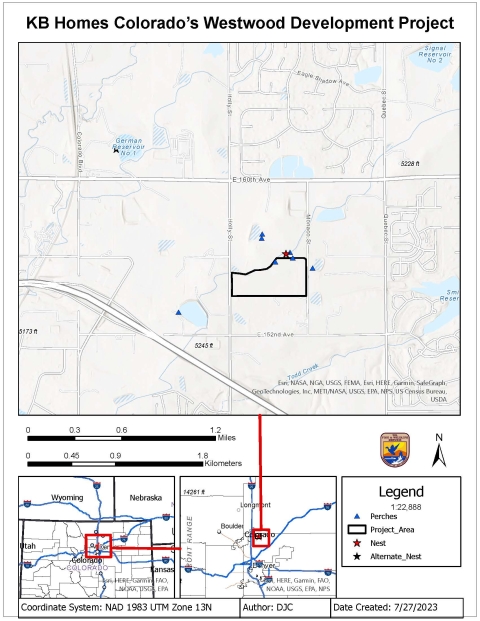Project Description
KB Home Colorado, Inc (Applicant) is the developer of KB Home Colorado’s Westwood Development Project (Project) in Adams County, Colorado. The Project is a single-family home development consisting of houses, a detention pond, waterlines, sewer infrastructure, roads, driveways, and landscaping. The Applicant submitted an Incidental Eagle Take Permit (IETP) application to the U.S. Fish and Wildlife Service (Service) requesting a 5-year disturbance take permit.
Potential Eagle Impacts
The Project boundary is located within the 330-foot buffer of the bald eagle nest. The bald eagle pair successfully fledged two offspring from the nest in 2021 and 2022 and as of June 6, 2023, one eaglet has fledged and the other was still in the nest. During this timeframe, ERO Resources Corporation conducted frequent disturbance monitoring during the nesting seasons while the initial site preparation and construction activities for the Project occurred, outside the 660-foot buffer. Take, including killing of eagles, is prohibited by the 2016 Bald and Golden Eagle Protection Act (Eagle Act). However, the Service has been delegated the authority to issue IETPs, where the take is determined to be compatible with the preservation of eagles. The Service will issue IETPs for such take only after an applicant has committed to undertake all practical measures to avoid and minimize such take and mitigate anticipated take to the maximum extent achievable.
The Applicant has submitted a permit application that summarizes project design, construction and operational measures taken to avoid and minimize impacts to eagles, and results of disturbance monitoring efforts.
The Service has completed an Environmental Assessment (EA) for the potential issuance of the permit decision under the 2016 Eagle Act regulations. The EA assesses the potential effects of issuing an IETP and a No Action alternative (i.e., do not issue a permit) on the human and natural environment. The expected loss for each instance of authorized nest disturbance is 1.33 bald eagles per year (USFWS, 2009). We have determined that this level of take from the Project’s Eagle Management Unit and the Local Area Population meets the Eagle Act preservation standard.
Project Review
The Service has an independent statutory responsibility under the National Environmental Policy Act (NEPA) to evaluate its own actions related to the Project, namely the possible issuance of an IETP. A draft EA evaluating the impact of issuing (and not issuing) an IETP for the Project was made available for a 30-day public comment period. It has been determined that there is no new significant information, and the Service has prepared a Finding of No Significant Impact (FONSI) in accordance with NEPA regulations (40 C.F.R § 1508.13). An Incidental Eagle Take Permit will be issued under the 2016 Eagle Act regulations and will authorize non-purposeful disturbance take of bald eagles.
News and Updates
The Service is releasing the final EA, FONSI, and findings document for the issuance of an IETP for the risk of bald eagle disturbance take associated with the Project. The 5-year permit authorizes the potential disturbance take of a bald eagle nest associated with the construction of the Project and outlines required conservation measures for minimizing and offsetting potential disturbance take of bald eagles, pursuant to the 2016 regulations of the Eagle Act.
Documents
Relevant documents, linked below, include the Environmental Assessment, Finding of No Significant Impact, and the Intra-service Section-7 Biological Evaluation Form.






